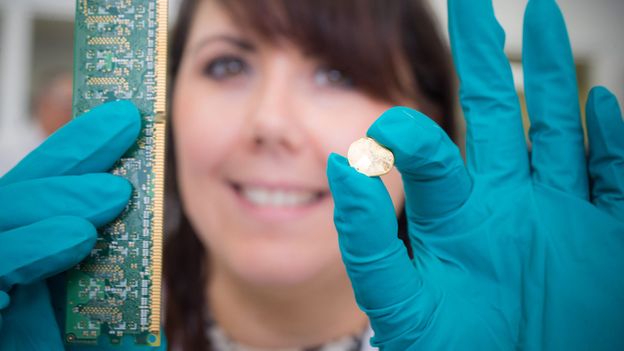Summary
The UK Royal Mint has developed an innovative method to extract precious metals, particularly gold, from electronic waste such as discarded laptops and mobile phones. This sustainable and energy-efficient process claims to recover 99% of gold from printed circuit boards, and the Royal Mint plans to open a factory capable of processing 90 tonnes of circuit boards per week, potentially recovering hundreds of kilograms of gold annually. The method involves a chemical solution that dissolves and leaches gold at room temperature and is “environmentally friendly”, producing fewer greenhouse gas emissions than traditional smelting methods. The initiative aims to reduce e-waste and the environmental impact of mining for raw materials.
Other Details
-
E-waste is a rapidly growing waste stream, with an estimated 50 million tonnes produced globally each year.
-
Only 20% of e-waste is formally recycled, with the rest often sent to landfill or incinerated.
-
The Royal Mint’s initiative is focused on sustainable recycling within the UK and reducing the need to export e-waste for processing.
-
The method has the potential to recover other precious metals like palladium, silver, and copper.
-
The goal is to establish a network of local e-waste suppliers and processors to encourage reuse and reduce waste miles.
-
The Royal Mint aims to generate 70% of its required power from renewables, including energy produced from the waste processing.
-
There is growing interest in recycling e-waste to recover valuable materials and reduce the environmental impact of mining for these resources. Innovative methods like this could drive the growth of a more circular economy for precious metals.
The method involves a chemical solution that dissolves and leaches gold at room temperature and is “environmentally friendly”
Strategic quotes deploy! If it’s anything like the methods I’ve seen, then that’s some really generous usage of the words environmentally and friendly next to each other.
I’ve recycled old ram trimmings to recover 2.5g of gold for use in my fiancée’s engagement ring (wasn’t enough for the whole ring, but it’s the thought that counts.
If you do it right, the only byproducts are salt, carbon dioxide, oxygen, and water.
Copper (II) chloride dissolves the copper and makes Copper (I) chloride. Mix with sulfuric acid and get CuSO4 and HCl. CuSO4 can have the copper plated out of it and get more sulfuric acid, and HCl can be mixed with Copper (I) chloride to recycle back into copper (II) chloride.
So you’re left with gold and other bits. You can dissolve the gold in a mixture of nitric and Hydrochloric acid to get chloroauric acid. Wash with water and you now have a beaker of gold in solution that looks like an alcoholic’s piss.
Then bubble in sulfur dioxide and you get gold, Hydrochloric acidic and sulfuric acid.
So if you play it right, it’s infinitely recyclable. You just need electricity and heat to keep recovering the waste materials.
The problem I mostly ran into was ending up with a shitload of HCl. The store bought stuff is 30%, but the best you can recover through distillation is 20%. It takes a LOT of baking powder to neutralize it.
That sounds like a fun experiment to go through. Are any of these ingredients hard to come by? And is there something explicitly dangerous besides the usual “don’t breath in directly from the beaker and don’t put acid on yourself”?
The most dangerous is probably the sulfuric and nitric acid. Sulfuric acid has earned its nickname “oil of vitriol.” 99% sulfuric will burn through paper in seconds. Skin and paper have a lot in common. Didn’t play much with the nitric acid, but I’ve heard it’s angry. You really only need a small amount to help the hydrochloric acid dissolve the gold. Also sulfur dioxide is hella nasty smelling.
Nitric acid is the single hardest ingredient to get. I found a seller on eBay. I think you can make nitric acid with store bought chemicals though, but I never had to do that.
Other ingredients:
Hydrochloric acid - sold as concrete cleaner Sulfuric acid - sold (diluted) as battery acid. Easy to concentrate with a condenser. Unlike HCl, you can get like 99% purity through distillation. Copper Chloride - Drop some copper into a bath of hydrochloric acid and hydrogen peroxide Sulfur Dioxide - Mix sodium metabisulfite with an acid. Sodium metabisulfite is commercially used in some food/beverage preservatives. I bought a bag of it of amazon that was marketed towards brewers. SO
Also, they’re saying they will recover “hundreds of kilos” (let’s call that two hundred!) from… 4.68 million kilos of circuit board!
Where’s the rest of it going?!?
Asia usually.
Yeah, it’s sort of hard to define “environmentally friendly.” We fart. That’s OK, totally natural, environmentally friendly, right? 7 billion of us fart? Well, that’s stinking greenhouse gas right there…
How about reusing it for practical purposes and not for useless decorations?
My friend asked me, “Hey, how do you like gold?”
“Well, it conducts electricity really well. Very malleable, and can be made in a very thin sheet. Invaluable in semiconductors.”
I am still friend with that MatEng guy.
Madonna:
:max_bytes(150000):strip_icc():focal(596x0:598x2):format(webp)/madonna1-1-3a8dc8e6fe9e4ca39a56a9c894a33e0b.jpg)
Photo: Jeff Kravitz/FilmMagic





